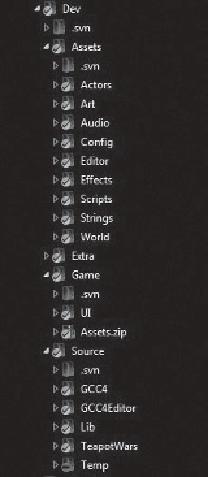Game Development Reference
In-Depth Information
Figure 21.2
TeapotWars directory structure.
the game-specific C++ code for the entire game. Notice how there aren
'
t many files
here. Most of the game
s complexity comes from the engine itself and the Lua game-
play code. You
'
ll find the solution file in Dev/Source/TeapotWars/Msvc. The directory
structure of Teapot Wars (see Figure 21.2) should look very familiar; it
'
'
s the exact
same directory structure Mike showed you in Chapter 4,
“
Building Your Game.
”
'
Once you have the game project set up, it
s time to create the core classes used to
manage the game. These classes are extensions of the application, logic, and view
classes you saw in previous chapters, and they manage your game-specific C++
code and override any virtual functions that need overriding.
The next major components to the game project are the event system and process
system. You are likely to have many game-specific events and processes that will
need to be written. They should all go here as well.
The majority of your gameplay systems should be written (or at least prototyped) in
Lua. You will need to decide how these systems will be structured and distributed.
You may need to write some game-specific Lua glue functions, although much of
the communication can and should happen through the event system.

